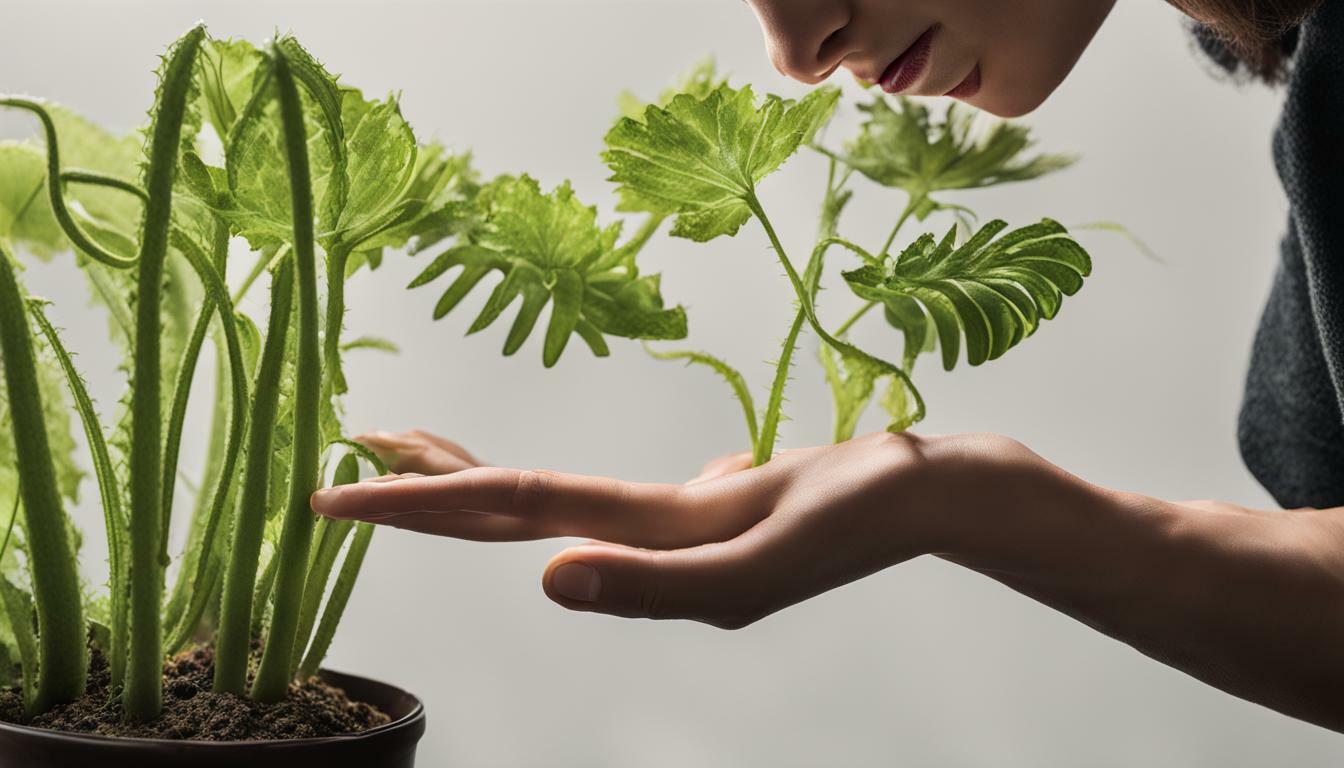Have you ever been fascinated by the Venus flytrap’s carnivorous nature and wondered if it’s safe to touch or handle it? While these intriguing plants are known for their unique ability to trap and digest insects, they can also pose potential risks to humans if not handled with care.
In this section, we will explore the potential consequences of touching a Venus flytrap and the risks associated with handling these captivating plants. You will learn about the defense mechanism of the Venus flytrap and how it responds to physical contact, and we will provide essential guidelines and precautions for safely handling it. We will also discuss the possibility of skin reactions or allergies that may occur when coming into contact with a Venus flytrap and how to mitigate these risks.
Key Takeaways
- Touching or handling a Venus flytrap can pose potential risks to humans.
- The Venus flytrap has a unique defense mechanism that responds to physical contact.
- Guidelines and precautions must be followed to safely handle a Venus flytrap.
- Skin reactions or allergies are possible when coming into contact with a Venus flytrap.
Understanding the Venus Flytrap’s Defense Mechanism
When you see a Venus flytrap, it’s hard not to be tempted to touch it or even poke at it. However, you shouldn’t underestimate the plant’s defense mechanism. While it may seem harmless, touching a Venus flytrap can have consequences.
When physical contact is made with the Venus flytrap’s sensory hairs, it triggers an electrical impulse that instructs the trap to snap shut. The trap’s interior surface is lined with small, hair-like structures that interlock, preventing any prey from escaping. If you touch a Venus flytrap, you risk triggering this mechanism and becoming trapped.
While it is possible to free yourself from a closed trap, doing so may cause harm. The more you struggle, the tighter the grip becomes, and the likelihood of injuring the sensitive leaves or triggering further closure increases.
Additionally, touching a Venus flytrap repeatedly could cause harm to the plant itself. The more times the trap is triggered, the more energy it expends, meaning it may eventually starve and die.
In short, while you may be tempted to touch a Venus flytrap out of curiosity, doing so could harm both you and the plant.
Precautions for Handling Venus Flytraps
Now that you understand the potential risks of touching a Venus flytrap, it’s essential to take the necessary precautions when handling these fascinating plants. Here are some essential guidelines to follow for safe handling:
- Do not touch the trap: While it may be tempting to see the trap close up, refrain from touching it. The trap is sensitive to any physical contact, and it may trigger its defense mechanism even without prey.
- Use tweezers: If you need to handle the Venus flytrap, use tweezers or a similar tool to avoid direct contact with your fingers or hands. However, keep in mind that it’s best to minimize any physical contact.
- Water carefully: When watering a Venus flytrap, make sure to avoid getting water on the leaves and traps. Only water the soil, and use distilled water or rainwater, as tap water may contain minerals that can harm the plant.
- Provide adequate lighting: Venus flytraps require plenty of sunlight to thrive. Ensure that the plant receives at least six hours of direct sunlight per day by placing it in a sunny window or outside in direct sunlight.
- Ensure proper soil conditions: Venus flytraps need a specific type of soil that is low in nutrients and acidic. Plant them in sphagnum peat moss or a similar medium to ensure proper growth and development.
- Avoid misting: While many plants benefit from misting, Venus flytraps do not. Misting can cause excess moisture, which can lead to rotting and other plant health issues.
By following these simple precautions, you can safely handle a Venus flytrap and ensure its well-being. Remember, these plants are not toys or novelties – they are living organisms that require proper care and respect.
Potential Skin Reactions and Allergies
While the Venus flytrap may be intriguing to touch, it’s essential to be aware of the potential skin reactions or allergies that may occur when you come into contact with it. The Venus flytrap produces a clear, sticky substance on its leaves and traps that can cause skin irritation, redness, and even blisters.
If you do happen to touch a Venus flytrap, make sure to rinse the affected area thoroughly with soap and water. Avoid rubbing or scratching the area, as this can aggravate the skin further. If you experience an allergic reaction, seek medical attention immediately.
Individuals with sensitive skin or a history of allergies should take extra precautions when handling Venus flytraps. Wearing gloves and protective clothing is recommended, as well as avoiding touching your face or eyes while handling the plant.
In summary, it’s crucial to approach the Venus flytrap with caution and respect for its defenses. By taking the necessary precautions and understanding the potential risks, you can safely admire this fascinating carnivorous plant.
Conclusion
In conclusion, it is not recommended to touch or handle Venus flytraps without taking proper precautions. The potential consequences of physical contact with these plants can result in harm to both the plant and human. Understanding the Venus flytrap’s defense mechanism is crucial for safe handling and avoiding potential skin reactions or allergies. To ensure the safe handling of Venus flytraps, it is essential to follow the guidelines and precautions discussed in this article. Always keep in mind that these plants are sensitive and delicate, and any mishandling can result in harm or even death. In summary, the Venus flytrap is a fascinating plant, but it should be respected and handled with care. By taking the necessary precautions and following the guidelines discussed in this article, you can safely enjoy the wonder of these captivating plants without any risks to your health or the well-being of the plant.What Are the Consequences of Touching a Venus Flytrap?
Touching a Venus Flytrap may lead to the venus flytrap’s bite effects and consequences. This carnivorous plant has sensitive trigger hairs, and if stimulated, it snaps shut its leaves. While its bite won’t harm humans, repeated touching may stress the plant, affecting its ability to catch prey efficiently. It’s essential to admire these fascinating plants from a safe distance.
FAQ
Q: Is it bad to touch a Venus flytrap?
A: While it is not necessarily “bad” to touch a Venus flytrap, it is important to exercise caution due to the plant’s unique defense mechanism.
Q: What are the risks of handling a Venus flytrap?
A: Handling a Venus flytrap can potentially trigger its defense mechanism, causing the plant’s leaves to close shut. This can lead to damage or even death of the plant if done excessively or forcefully.
Q: How does a Venus flytrap defend itself?
A: The Venus flytrap has tiny trigger hairs on its leaves. When these hairs are touched, the plant’s leaves snap shut, trapping any prey that may have come in contact with it.
Q: What precautions should I take when handling a Venus flytrap?
A: When handling a Venus flytrap, it is important to avoid unnecessary touching or triggering of the plant’s leaves. Gently touching the leaves for observation or feeding purposes is acceptable, but excessive or forceful handling should be avoided.
Q: Can touching a Venus flytrap cause skin reactions or allergies?
A: While rare, some individuals may experience skin reactions or allergies when coming into contact with a Venus flytrap. It is recommended to wash hands thoroughly after handling to minimize any potential risks.











